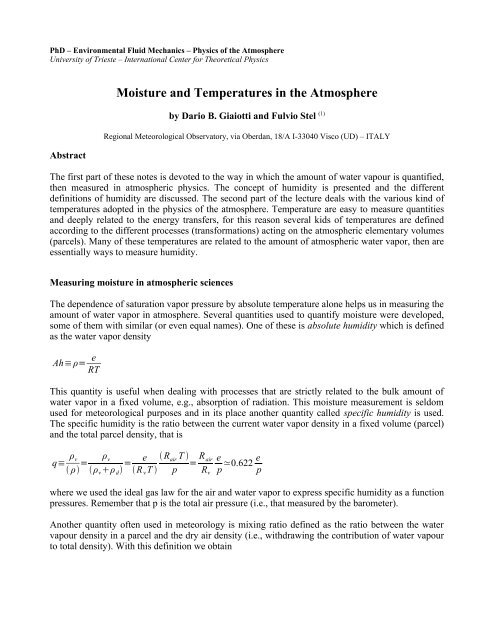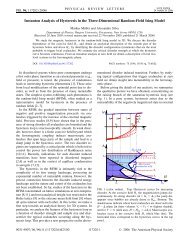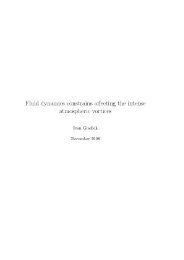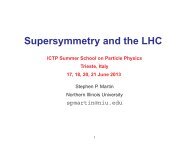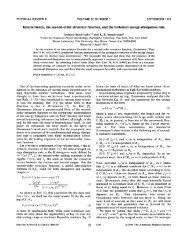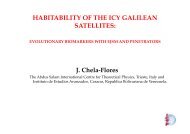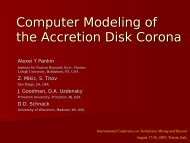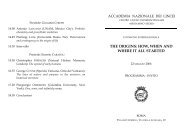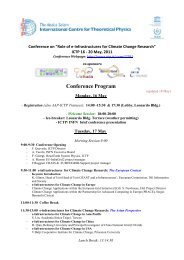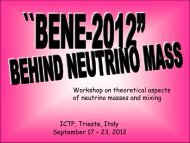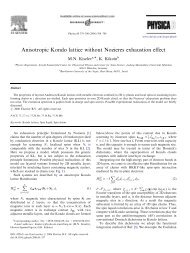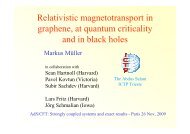Moisture and Temperatures in the Atmosphere - ICTP
Moisture and Temperatures in the Atmosphere - ICTP
Moisture and Temperatures in the Atmosphere - ICTP
You also want an ePaper? Increase the reach of your titles
YUMPU automatically turns print PDFs into web optimized ePapers that Google loves.
PhD – Environmental Fluid Mechanics – Physics of <strong>the</strong> <strong>Atmosphere</strong><br />
University of Trieste – International Center for Theoretical Physics<br />
Abstract<br />
<strong>Moisture</strong> <strong>and</strong> <strong>Temperatures</strong> <strong>in</strong> <strong>the</strong> <strong>Atmosphere</strong><br />
by Dario B. Giaiotti <strong>and</strong> Fulvio Stel (1)<br />
Regional Meteorological Observatory, via Oberdan, 18/A I-33040 Visco (UD) – ITALY<br />
The first part of <strong>the</strong>se notes is devoted to <strong>the</strong> way <strong>in</strong> which <strong>the</strong> amount of water vapour is quantified,<br />
<strong>the</strong>n measured <strong>in</strong> atmospheric physics. The concept of humidity is presented <strong>and</strong> <strong>the</strong> different<br />
def<strong>in</strong>itions of humidity are discussed. The second part of <strong>the</strong> lecture deals with <strong>the</strong> various k<strong>in</strong>d of<br />
temperatures adopted <strong>in</strong> <strong>the</strong> physics of <strong>the</strong> atmosphere. Temperature are easy to measure quantities<br />
<strong>and</strong> deeply related to <strong>the</strong> energy transfers, for this reason several kids of temperatures are def<strong>in</strong>ed<br />
accord<strong>in</strong>g to <strong>the</strong> different processes (transformations) act<strong>in</strong>g on <strong>the</strong> atmospheric elementary volumes<br />
(parcels). Many of <strong>the</strong>se temperatures are related to <strong>the</strong> amount of atmospheric water vapor, <strong>the</strong>n are<br />
essentially ways to measure humidity.<br />
Measur<strong>in</strong>g moisture <strong>in</strong> atmospheric sciences<br />
The dependence of saturation vapor pressure by absolute temperature alone helps us <strong>in</strong> measur<strong>in</strong>g <strong>the</strong><br />
amount of water vapor <strong>in</strong> atmosphere. Several quantities used to quantify moisture were developed,<br />
some of <strong>the</strong>m with similar (or even equal names). One of <strong>the</strong>se is absolute humidity which is def<strong>in</strong>ed<br />
as <strong>the</strong> water vapor density<br />
Ah≡ ρ= e<br />
RT<br />
This quantity is useful when deal<strong>in</strong>g with processes that are strictly related to <strong>the</strong> bulk amount of<br />
water vapor <strong>in</strong> a fixed volume, e.g., absorption of radiation. This moisture measurement is seldom<br />
used for meteorological purposes <strong>and</strong> <strong>in</strong> its place ano<strong>the</strong>r quantity called specific humidity is used.<br />
The specific humidity is <strong>the</strong> ratio between <strong>the</strong> current water vapor density <strong>in</strong> a fixed volume (parcel)<br />
<strong>and</strong> <strong>the</strong> total parcel density, that is<br />
q≡ ρv ρ =<br />
ρv e Rair T <br />
=<br />
ρvρ d R vT p = Rair e e<br />
≃0.622<br />
Rv p p<br />
where we used <strong>the</strong> ideal gas law for <strong>the</strong> air <strong>and</strong> water vapor to express specific humidity as a function<br />
pressures. Remember that p is <strong>the</strong> total air pressure (i.e., that measured by <strong>the</strong> barometer).<br />
Ano<strong>the</strong>r quantity often used <strong>in</strong> meteorology is mix<strong>in</strong>g ratio def<strong>in</strong>ed as <strong>the</strong> ratio between <strong>the</strong> water<br />
vapour density <strong>in</strong> a parcel <strong>and</strong> <strong>the</strong> dry air density (i.e., withdraw<strong>in</strong>g <strong>the</strong> contribution of water vapour<br />
to total density). With this def<strong>in</strong>ition we obta<strong>in</strong>
ρ v<br />
r≡ ρv ρdry =<br />
e<br />
=<br />
ρair− ρv RvT <br />
<br />
1<br />
p<br />
RairT <br />
e<br />
−<br />
R v T = R air<br />
Rv e<br />
p− R air<br />
R v<br />
e<br />
e<br />
≃0.622<br />
~0.622<br />
p−0.622e p<br />
e<br />
This means that for almost all <strong>the</strong> meteorological purposes mix<strong>in</strong>g ratio <strong>and</strong> specific humidity can be<br />
considered almost <strong>the</strong> same (substitute p=1013 hPa <strong>and</strong> e =6.11 hPa <strong>in</strong> <strong>the</strong> above formula for a<br />
check).<br />
Both <strong>the</strong> above def<strong>in</strong>itions, even if widely used <strong>in</strong> atmospheric physics, have two slight<br />
disadvantages: <strong>the</strong> first is that both depend upon air pressure (<strong>the</strong> same amount of water vapour<br />
molecules has a different specific humidity <strong>and</strong> mix<strong>in</strong>g ratio for different air pressures); <strong>the</strong> second is<br />
that both specific humidity <strong>and</strong> mix<strong>in</strong>g ratio do not give any <strong>in</strong>formation concern<strong>in</strong>g where are we <strong>in</strong><br />
respect to saturation.<br />
The first disadvantage is more <strong>the</strong>oretical than practical (meteorologists are very rude people). In fact<br />
for <strong>the</strong> great majority of purposes pressure, dur<strong>in</strong>g horizontal (equipotential, <strong>in</strong>deed) displacements,<br />
just by a few tens of hPa. Try to substitute 1013 hPa with 993 hPa or 1033 hPa to have an idea of<br />
pressure <strong>in</strong>fluence on specific humidity <strong>and</strong> mix<strong>in</strong>g ratio.<br />
The second disadvantage is a little bit more tricky. In fact for <strong>the</strong> great majority of situations, water<br />
vapour is negligible apart when condensation takes place. In that case even if <strong>the</strong> amount of water<br />
vapour is small compared to <strong>the</strong> rema<strong>in</strong><strong>in</strong>g atmospheric constituents, because of its latent heat of<br />
condensation, its presence becomes fundamental for atmospheric (<strong>the</strong>rmo)dynamics.<br />
For this reason meteorologists <strong>in</strong>vented ano<strong>the</strong>r quantity to quantify moisture <strong>in</strong> atmosphere, which<br />
is relative humidity. Relative humidity is def<strong>in</strong>ed as <strong>the</strong> ratio between <strong>the</strong> observed water vapour<br />
amount <strong>and</strong> <strong>the</strong> saturation for <strong>the</strong> observed parcel's fixed temperature. The def<strong>in</strong>ition seems<br />
straightforward but conceptually it depends by <strong>the</strong> way <strong>in</strong> which you def<strong>in</strong>e <strong>the</strong> “water vapour<br />
amount”. Two def<strong>in</strong>itions are available <strong>and</strong> are used, <strong>the</strong> first recommended by WMO uses <strong>the</strong><br />
mix<strong>in</strong>g ratio r, <strong>the</strong> second used <strong>in</strong> <strong>the</strong> great majority of applications <strong>and</strong> textbooks uses <strong>the</strong> specific<br />
humidity q. The two def<strong>in</strong>itions of relative humidity follow here below<br />
r h = r<br />
=<br />
r s<br />
0.622e<br />
p−0.622e<br />
r h = q<br />
=<br />
qs 0.622e<br />
p<br />
p<br />
0.622e s<br />
p−0.622e s <br />
0.622e s<br />
= e<br />
e s<br />
= e p−0.622e s es p−0.622e<br />
The fact we used <strong>the</strong> same acronym is not due to a typo but that is exactly what is currently done <strong>in</strong><br />
all <strong>the</strong> <strong>the</strong>oretical <strong>and</strong> operational activities. In o<strong>the</strong>r words you cannot be sure what k<strong>in</strong>d of<br />
def<strong>in</strong>ition of relative humidity is adopted apart when explicitly written.<br />
In this case Nature helps mank<strong>in</strong>d because for almost all <strong>the</strong> meteorological purposes <strong>the</strong> two<br />
def<strong>in</strong>itions give almost <strong>the</strong> same result. The reason why textbooks recommend specific humidity as a<br />
moisture quantifier is that with specific humidity relative humidity does not depend upon pressure<br />
(nei<strong>the</strong>r slightly).<br />
Relative humidity, often represented <strong>in</strong> percent values, gives you all <strong>the</strong> fundamental <strong>in</strong>formation<br />
you need concern<strong>in</strong>g how far we are from saturation, but has <strong>the</strong> great disadvantage to be<br />
temperature dependent, <strong>in</strong> fact saturation specific humidity (or saturation mix<strong>in</strong>g ratio) depends from<br />
temperature. For this reason ano<strong>the</strong>r moisture measurement is often used that is <strong>the</strong> dew po<strong>in</strong>t<br />
temperature.
<strong>Temperatures</strong> <strong>in</strong> atmosphere<br />
Temperature is a fundamental variable for <strong>the</strong> description <strong>and</strong> prediction of atmospheric<br />
processes because it gives <strong>in</strong>formation concern<strong>in</strong>g <strong>the</strong> direction <strong>in</strong> which <strong>the</strong> exchanges of <strong>the</strong>rmal<br />
energy take place. But <strong>the</strong> temperature of an air-mass or better of an air parcel can change<br />
accord<strong>in</strong>gly to its evolution, it is useful to <strong>in</strong>troduce several “temperatures” that are not real <strong>in</strong> <strong>the</strong><br />
sense that <strong>the</strong>y can be currently measured by a simple <strong>the</strong>rmometer, but <strong>the</strong>y are go<strong>in</strong>g to be reached<br />
when an air parcel is subject to a well def<strong>in</strong>ed transformation. For this reason <strong>the</strong>se temperatures are<br />
function of <strong>the</strong> current air parcel properties (e.g. fraction of water vapor, ...) <strong>and</strong> of <strong>the</strong><br />
transformation (e.g., isobaric, adiabatic, ...).<br />
Dew po<strong>in</strong>t temperature<br />
Dew temperature is def<strong>in</strong>ed as <strong>the</strong> temperature reached by an air-mass when it is cooled<br />
isobarically, keep<strong>in</strong>g constant its content of water vapor (e.g, de/dt=0 ), up to <strong>the</strong> level <strong>in</strong> which <strong>the</strong><br />
condensation of water vapor takes place. This temperature can be computed us<strong>in</strong>g <strong>the</strong> Clausius-<br />
Clapeyron equation<br />
des 1<br />
=<br />
dT T<br />
l v<br />
ν v−ν w<br />
where es is <strong>the</strong> saturation vapor pressure, T <strong>the</strong> absolute temperature, lv <strong>the</strong> latent heat of<br />
condensation per unit mass <strong>and</strong> νv <strong>and</strong> νw are respectively <strong>the</strong> specific volume (<strong>in</strong>verse of density) of<br />
water vapor <strong>and</strong> liquid water.<br />
The above equation can be simplified, for atmospheric purposes, keep<strong>in</strong>g <strong>in</strong> m<strong>in</strong>d that <strong>the</strong> specific<br />
volume of water is usually very small compared to <strong>the</strong> specific volume of vapour (i.e., <strong>the</strong> density of<br />
liquid water is usually higher than water vapor density) <strong>the</strong>n we can write<br />
de s<br />
dT ≈ l V<br />
T v V<br />
approximat<strong>in</strong>g <strong>the</strong> behavior of water vapor with an ideal gas we can write e s = ρ v R v T that, when<br />
<strong>in</strong>serted <strong>in</strong>to <strong>the</strong> above equation, becomes<br />
de s<br />
dT ≈ l V e s<br />
R V T 2<br />
This equation, when <strong>in</strong>tegrated, gives <strong>the</strong> follow<strong>in</strong>g result<br />
e s<br />
e ref<br />
≈ e<br />
l V<br />
R V T ref<br />
l V<br />
R V T<br />
e<br />
that can be written <strong>in</strong> <strong>the</strong> follow<strong>in</strong>g, more readable, form<br />
e s ≈ Ae − l V<br />
R V T
l V<br />
where A=e ref exp is a constant that can be experimentally determ<strong>in</strong>ed for a reference<br />
RV T ref<br />
temperature T ref . This constant depends, once <strong>the</strong> reference temperature is fixed, depends only from<br />
<strong>the</strong> latent heat of vaporization <strong>and</strong> from <strong>the</strong> water vapor “gas constant”. Latent heat of vaporization is<br />
not strictly constant, but it just slightly decreases with <strong>the</strong> <strong>in</strong>creas<strong>in</strong>g of temperature (less than 1% for<br />
<strong>the</strong> meteorological temperature range, l V≃2.5⋅10 6 J kg −1<br />
at 0 °C <strong>and</strong> l V≃2.3⋅10 6 J kg −1<br />
at 100 °C),<br />
for this reason it can be considered as constant. The above equation states that saturation water vapor<br />
pressure (over liquid water) is function of temperature only <strong>and</strong>, once <strong>in</strong>verted, it can be used to<br />
determ<strong>in</strong>e <strong>the</strong> dew po<strong>in</strong>t temperature of an air-mass, <strong>the</strong>n<br />
T dew ≈<br />
l V<br />
R V ln A<br />
e <br />
Dew po<strong>in</strong>t temperature does not depend from total dry air pressure p d or from o<strong>the</strong>r variables than<br />
its partial vapor pressure e , for this reason it is a good marker of air-masses. In particular dew po<strong>in</strong>t<br />
temperature does not change if we modify its temperature only, <strong>the</strong>n it can characterize an air-mass<br />
<strong>in</strong> spite of its diabatic heat<strong>in</strong>g due to, as an example, <strong>the</strong> diurnal cycle.<br />
Fig.0. Dew po<strong>in</strong>t temperature (solid l<strong>in</strong>e), temperature (dashed l<strong>in</strong>e with crosses) <strong>and</strong> relative<br />
humidity (dotted l<strong>in</strong>e with ) as measured by <strong>the</strong> Vivaro wea<strong>the</strong>r station (Friuli Venezia Giulia) dur<strong>in</strong>g<br />
a tornado event that took place <strong>in</strong> <strong>the</strong> day of 4 th June 1999 at 09:20 UTC.<br />
It can be useful, for didactic purposes, to express dew po<strong>in</strong>t temperature as a function of relative<br />
humidity. In fact, once <strong>the</strong> air-mass relative humidity rh= e<br />
is known as well as its absolute<br />
es
temperature, us<strong>in</strong>g <strong>the</strong> saturation water vapor pressure equation we can obta<strong>in</strong> its current partial<br />
vapor pressure e , <strong>the</strong>n accord<strong>in</strong>g to <strong>the</strong> isobaric transformation that def<strong>in</strong>es dew po<strong>in</strong>t temperature,<br />
e will stay constant up to <strong>the</strong> moment <strong>in</strong> which saturation occurs. For an air-mass characterized by<br />
<strong>the</strong> relative humidity rh (expressed <strong>in</strong> relative values) <strong>and</strong> <strong>the</strong> absolute temperature T, <strong>the</strong> dew po<strong>in</strong>t<br />
temperature T dew becomes<br />
T<br />
T dew =<br />
1− Rv T<br />
ln rh<br />
l V<br />
S<strong>in</strong>ce l v≫ R V T <strong>the</strong> above equation states that dew po<strong>in</strong>t temperature is always lower than <strong>the</strong><br />
observed <strong>the</strong>rmometer temperature <strong>and</strong>, for a fixed temperature, it <strong>in</strong>creases with <strong>the</strong> <strong>in</strong>creas<strong>in</strong>g of<br />
relative humidity, co<strong>in</strong>cid<strong>in</strong>g with <strong>the</strong> observed <strong>the</strong>rmometer temperature at saturation, that is when<br />
relative humidity rh=1 .<br />
Before to conclude <strong>the</strong> part related to <strong>the</strong> dew po<strong>in</strong>t, it is important to compute how dew po<strong>in</strong>t<br />
temperature changes with height. This can be easily done simply tak<strong>in</strong>g <strong>the</strong> z derivative of <strong>the</strong><br />
equation that gives T dew as a function of vapor pressure e . This differentiation gives<br />
d<br />
dz T dew = R v<br />
l V<br />
2<br />
T dew<br />
e<br />
d<br />
dz e<br />
S<strong>in</strong>ce e is proportional to <strong>the</strong> dry air pressure p d by way of <strong>the</strong> relationship<br />
e= Rd r pd Rv obta<strong>in</strong>ed through <strong>the</strong> def<strong>in</strong>ition of mix<strong>in</strong>g ratio r≡e/ p d ⋅R d / R v , <strong>the</strong> above derivative becomes<br />
d<br />
dz T dew = R v<br />
l V<br />
2<br />
T dew<br />
pd d<br />
dz p d <br />
<strong>the</strong>n, us<strong>in</strong>g <strong>the</strong> equation of state for dry air ρ, we obta<strong>in</strong><br />
d<br />
dz T dew = R v<br />
l V<br />
2<br />
T dew<br />
Rd T<br />
1<br />
ρ d<br />
d<br />
dz p d <br />
At this po<strong>in</strong>t, assum<strong>in</strong>g <strong>the</strong> hydrostatic approximation 1<br />
simplify <strong>the</strong> above equation, that is<br />
d<br />
dz T dew=− Rv g<br />
Rd lV 2<br />
T dew<br />
T<br />
ρ d<br />
d<br />
dz p d =−g , we can significantly<br />
remember<strong>in</strong>g that <strong>the</strong> dry adiabatic lapse rate is given by <strong>the</strong> relation Γ d=−g /c p<br />
d , where cd<br />
p is <strong>the</strong><br />
specific heat at constant pressure for dry air, we can easily show that
Γ dew = d<br />
dz T dew= R d<br />
v c p<br />
Rd l V<br />
2<br />
T dew<br />
T Γ d<br />
Substitut<strong>in</strong>g <strong>the</strong> constants <strong>and</strong> assum<strong>in</strong>g that T dew≈270 <strong>and</strong> T ≈280 (<strong>the</strong> current values, be<strong>in</strong>g <strong>in</strong><br />
<strong>the</strong> absolute scale, are not extremely important) we will have Γ dew ≈0.2 Γ d . This simple equation<br />
gives <strong>the</strong> explanation of <strong>the</strong> cloud formation. In fact that relationship states that <strong>the</strong> <strong>the</strong>rmal lapse rate<br />
of dry air is greater (<strong>in</strong> absolute value) than <strong>the</strong> dew po<strong>in</strong>t lapse rate. This means that, dur<strong>in</strong>g <strong>the</strong><br />
adiabatic ascent (cool<strong>in</strong>g), <strong>the</strong> temperature of dry air decreases more than its dew po<strong>in</strong>t temperature.<br />
This is <strong>the</strong> reason why a lifted parcel of air might reach saturation. There are some o<strong>the</strong>r vapors, <strong>in</strong><br />
any case not relevant under <strong>the</strong> meteorological po<strong>in</strong>t of view, where <strong>the</strong> dew po<strong>in</strong>t lapse rate is<br />
greater, <strong>in</strong> absolute value, than that of dry air. For those vapors clouds does not for because of <strong>the</strong><br />
lift<strong>in</strong>g but because of s<strong>in</strong>k<strong>in</strong>g.<br />
Wet bulb temperature<br />
Wet bulb temperature is def<strong>in</strong>ed as <strong>the</strong> temperature reached by air when liquid water<br />
ievaporates <strong>in</strong> it isobarically (e.g., at constant pressure) up to saturation. It is necessary not to confuse<br />
wet bulb temperature with dew po<strong>in</strong>t temperature. In fact dew po<strong>in</strong>t temperature is reached after an<br />
isobaric transformation (i.e., vapor pressure e is kept constant) <strong>in</strong> which temperature T decreases <strong>and</strong><br />
<strong>the</strong> mix<strong>in</strong>g ratio r is kept constant at <strong>the</strong> same time up to <strong>the</strong> temperature <strong>in</strong> which condensation<br />
occurs, that is<br />
de<br />
dt =0 , dT<br />
dt 0 <strong>and</strong> dr<br />
dt =0 .<br />
On <strong>the</strong> contrary wet bulb temperature is reached after an isobaric transformation of <strong>the</strong> air <strong>in</strong> which<br />
mix<strong>in</strong>g ratio is <strong>in</strong>creased by evaporation of water <strong>and</strong>, <strong>the</strong>n, at <strong>the</strong> same time temperature decreases<br />
up to <strong>the</strong> level <strong>in</strong> which <strong>the</strong> saturation equilibrium is reached, that is<br />
de<br />
dt =0 , dT<br />
dt 0 <strong>and</strong> dr<br />
dt 0 .<br />
Even if this transformation is quite simple to describe, it is not so easy to practically realize it.<br />
One possibility, that is exactly what is operationally done, is that of produc<strong>in</strong>g a steady flow of <strong>the</strong><br />
air we are <strong>in</strong>terested <strong>in</strong>, over a source of moisture (water). If <strong>the</strong> flow is enough strong, after a certa<strong>in</strong><br />
amount of time that depends from <strong>the</strong> mass <strong>and</strong> exposed surface of <strong>the</strong> moisture source, a steady<br />
state is reached <strong>in</strong> which <strong>the</strong> temperature of <strong>the</strong> moisture source is no more decreas<strong>in</strong>g. In this<br />
situation, <strong>the</strong> amount of <strong>the</strong>rmal energy given by <strong>the</strong> flow to <strong>the</strong> moisture source is exactly <strong>the</strong> same<br />
amount of energy taken by <strong>the</strong> evaporation of <strong>the</strong> moisture source. In fact <strong>the</strong> flow, at this regime,<br />
does not give anymore <strong>the</strong>rmal energy to <strong>the</strong> moisture source, o<strong>the</strong>rwise <strong>the</strong> moisture source<br />
temperature had to <strong>in</strong>crease. At <strong>the</strong> same time, <strong>the</strong> source of moisture is not giv<strong>in</strong>g anymore <strong>the</strong>rmal<br />
energy to <strong>the</strong> air flow, o<strong>the</strong>rwise <strong>the</strong> air flow temperature had to decrease. This is possible only when<br />
<strong>the</strong> outgo<strong>in</strong>g flow of air is saturated <strong>and</strong> when its temperature is <strong>the</strong> same of <strong>the</strong> moisture source,<br />
o<strong>the</strong>rwise we could not observed <strong>the</strong> equilibrium.<br />
The so called wet bulb equation (or psychrometric equation) describes <strong>the</strong> asymptotically<br />
reached dynamic equilibrium, <strong>and</strong> it is represented by <strong>the</strong> follow<strong>in</strong>g simple relationship
Q given byair=Q absorbed by evaporation<br />
which is based on <strong>the</strong> general pr<strong>in</strong>ciple of energy conservation. The first term of <strong>the</strong> above equation<br />
can be split <strong>in</strong>to <strong>the</strong> two components of energy given by <strong>the</strong> <strong>in</strong>com<strong>in</strong>g dry air <strong>and</strong> by water vapor,<br />
that is<br />
Q d Q v=Q absorbed byevaporation<br />
<strong>the</strong> second term can be written keep<strong>in</strong>g <strong>in</strong>to account <strong>the</strong> mass of liquid water transformed <strong>in</strong> vapor<br />
M v <strong>and</strong> <strong>the</strong> latent heat per unit mass L v , that is<br />
Q d Q v= M v L v<br />
at this po<strong>in</strong>t <strong>the</strong> <strong>the</strong>rmal energy given by dry air <strong>and</strong> water vapor can be written us<strong>in</strong>g <strong>the</strong> mass of dry<br />
air M d <strong>and</strong> <strong>the</strong> mass of water vapor M v<br />
v<br />
M d c p T M vc p T = M v Lv <strong>the</strong>n, divid<strong>in</strong>g by M d <strong>and</strong> remember<strong>in</strong>g that water vapor mix<strong>in</strong>g ratio is def<strong>in</strong>ed as<br />
r= M v<br />
M d<br />
<strong>the</strong> above equation becomes<br />
v<br />
c pr c pT<br />
=Lv r .<br />
If we write as T w <strong>and</strong> r s respectively <strong>the</strong> equilibrium temperature <strong>and</strong> <strong>the</strong> saturation mix<strong>in</strong>g ratio<br />
reached by <strong>the</strong> outgo<strong>in</strong>g flow while T <strong>and</strong> r represent <strong>the</strong> actual temperature <strong>and</strong> mix<strong>in</strong>g ratio of<br />
<strong>the</strong> <strong>in</strong>com<strong>in</strong>g air, <strong>the</strong> above equation becomes<br />
v<br />
c pr c pT<br />
−T w=L vr s−r<br />
where T w is <strong>the</strong> wet bulb temperature of <strong>the</strong> <strong>in</strong>com<strong>in</strong>g air.<br />
Wet bulb temperature is an extremely useful quantity <strong>in</strong> <strong>the</strong> atmosphere sciences for several reasons.<br />
First of all it can be used to measure <strong>the</strong> amount of moisture of <strong>the</strong> air <strong>in</strong> fact, know<strong>in</strong>g <strong>the</strong> wet bulb<br />
temperature <strong>and</strong> <strong>the</strong> current temperature, we can retrieve <strong>the</strong> current air mix<strong>in</strong>g ratio (remember that<br />
<strong>the</strong> saturation mix<strong>in</strong>g ratio r s can be determ<strong>in</strong>ed as a function of <strong>the</strong> wet bulb temperature <strong>and</strong><br />
pressure). Moreover, wet bulb temperature is <strong>the</strong> asymptotic value of <strong>the</strong> temperature reached by<br />
hydrometeors dur<strong>in</strong>g <strong>the</strong>ir fall <strong>in</strong>to <strong>the</strong> atmosphere, which is <strong>the</strong>n useful for <strong>the</strong> determ<strong>in</strong>ation of <strong>the</strong>ir<br />
melt<strong>in</strong>g <strong>and</strong>/or evaporat<strong>in</strong>g rate as well as for <strong>the</strong>ir impact on downdraft enhancement. Wet bulb<br />
temperature is even extremely useful <strong>in</strong> <strong>the</strong>rmodynamic diagrams, because it is connected with<br />
ano<strong>the</strong>r temperature, that is equivalent potential temperature, which is directly l<strong>in</strong>ked to <strong>the</strong><br />
atmospheric potential <strong>in</strong>stability.<br />
The differences between temperature <strong>and</strong> wet bulb temperature are shown <strong>in</strong> figure 1, where <strong>the</strong>se<br />
two variables are displayed <strong>in</strong> conjunction with <strong>the</strong> relative humidity.
Figure 1. Temperature, wet bulb temperature, dew po<strong>in</strong>t temperature <strong>and</strong> relative humidity as<br />
observed at Ud<strong>in</strong>e between 07:00 <strong>and</strong> 15:00 UTC (solar time – 2 hours) an 29 th March 2006.<br />
In figure 1 it is clear that temperature <strong>and</strong> wet bulb temperature differ quite a lot, specially when<br />
atmosphere is far from saturation, as evidenced by <strong>the</strong> relative humidity trend (lowest panel). This is<br />
as well an explanation of why we can keep a bottle of dr<strong>in</strong>k cooler than its surround<strong>in</strong>gs just<br />
ma<strong>in</strong>ta<strong>in</strong><strong>in</strong>g it constantly wet. Moreover it is an evidence of how smart had been Nature <strong>in</strong> us<strong>in</strong>g<br />
sweat<strong>in</strong>g to keep cool <strong>the</strong> human bodies.<br />
Wet bulb temperature depends form <strong>the</strong> mix<strong>in</strong>g ratios r s <strong>and</strong> r which, <strong>in</strong> turn, depend from<br />
pressure; for this reason wet bulb temperature depends from dry pressure as shown <strong>in</strong> figure 2. In<br />
that figure it is clear that <strong>the</strong> <strong>in</strong>creas<strong>in</strong>g of pressure produces a growth of wet bulb temperature. This<br />
can be naively <strong>in</strong>terpreted keep<strong>in</strong>g <strong>in</strong> m<strong>in</strong>d that <strong>in</strong>creas<strong>in</strong>g of pressure, keep<strong>in</strong>g constant <strong>the</strong> water<br />
vapor pressure <strong>and</strong> <strong>the</strong> saturation vapor pressure (which depends only from temperature), we cause a<br />
decrease <strong>in</strong> <strong>the</strong> mix<strong>in</strong>g ratio, which is def<strong>in</strong>ed as <strong>the</strong> ratio between <strong>the</strong> mass of water vapor per mass<br />
of dry air. Increas<strong>in</strong>g pressure, <strong>the</strong>n, we <strong>in</strong>crease <strong>the</strong> mass of dry air, <strong>the</strong>n we <strong>in</strong>crease <strong>the</strong> amount of<br />
<strong>the</strong>rmal energy given by <strong>the</strong> air to <strong>the</strong> source of moisture. The differences <strong>in</strong> wet bulb temperature<br />
due to dry air pressure, <strong>in</strong> any case, are not particularly huge, at least for <strong>the</strong> typical atmospheric<br />
conditions <strong>and</strong>, obviously, disappear at saturation, when temperature, dew po<strong>in</strong>t temperature <strong>and</strong> wet<br />
bulb temperature co<strong>in</strong>cide.<br />
Operationally, wet bulb temperature is used to compute <strong>the</strong> mix<strong>in</strong>g ratio of <strong>the</strong> air masses. This is<br />
done by way of two <strong>the</strong>rmometers, one with a bulb kept wet <strong>and</strong> <strong>the</strong> o<strong>the</strong>r with <strong>the</strong> bulb kept dry.<br />
Both <strong>the</strong>se <strong>the</strong>rmometers are ma<strong>in</strong>ta<strong>in</strong>ed under a vigorous steady vigorous (of <strong>the</strong> order of several<br />
meters per second). The difference observed <strong>in</strong> <strong>the</strong> two <strong>the</strong>rmometers, when equilibrium is reached,<br />
is used to compute <strong>the</strong> air mass mix<strong>in</strong>g ratio, <strong>the</strong>n <strong>the</strong> relative humidity. Before to conclude it is<br />
important to specify that <strong>the</strong> process which br<strong>in</strong>g to <strong>the</strong> wet bulb temperature, is not isentropic for <strong>the</strong><br />
air mass, <strong>in</strong> fact this process is not adiabatic s<strong>in</strong>ce <strong>the</strong>rmal energy is withdrawn from <strong>the</strong> air mass.
Figure 2. Temperature, wet bulb temperature for <strong>the</strong> observed pressure, wet bulb temperature for a<br />
10% <strong>in</strong>creased pressure <strong>and</strong> dew po<strong>in</strong>t temperature as observed at Ud<strong>in</strong>e between 07:00 <strong>and</strong> 15:00<br />
UTC (solar time – 2 hours) an 29 th March 2006.
Equivalent potential temperature<br />
Equivalent potential temperature is <strong>the</strong> temperature reached by an air parcel (mixture of dry<br />
air <strong>and</strong> water vapor) when adiabatically lifted (i.e., cooled) up to a pressure such that all <strong>the</strong> water<br />
vapor is condensed <strong>and</strong> <strong>the</strong>n brought back <strong>in</strong> a dry adiabatic descent (<strong>the</strong>n after remov<strong>in</strong>g all its water<br />
content) up to a st<strong>and</strong>ard level pressure (usually 1000 hPa). This temperature is considered important<br />
because this process mimic <strong>the</strong> lift<strong>in</strong>g of an air mass due to convection <strong>and</strong> it is useful to determ<strong>in</strong>e<br />
<strong>the</strong> potential <strong>and</strong> conditional <strong>in</strong>stability. Equivalent potential temperature is not a real adiabatic<br />
process because water is fully removed before to start <strong>the</strong> dry adiabatic descent. Even if not<br />
completely correct, this temperature is never<strong>the</strong>less called equivalent potential <strong>and</strong> adiabatic. The<br />
expression pseudo-equivalent potential temperature is reserved to <strong>the</strong> temperature reached by an air<br />
mass which is lifted adiabatically, remov<strong>in</strong>g <strong>the</strong> condensed water as soon as it is formed, up to a<br />
pressure when all <strong>the</strong> water vapor is condensed <strong>and</strong> <strong>the</strong>n draw back up to <strong>the</strong> st<strong>and</strong>ard level pressure<br />
with a dry (now all <strong>the</strong> water is disappeared) adiabatic descent. This temperature is called pseudoequivalent<br />
potential temperature because it is not a pure adiabatic process even dur<strong>in</strong>g <strong>the</strong> ascent of<br />
<strong>the</strong> air parcel <strong>in</strong> <strong>the</strong> sense that <strong>the</strong>re is an exchange of matter with <strong>the</strong> environment. Pseudoequivalent<br />
potential temperature mimic a process where <strong>the</strong> water condensed ra<strong>in</strong>s out as soon as it is<br />
formed, while equivalent potential temperature mimic a process where <strong>the</strong> condensed water ra<strong>in</strong>s out<br />
only from <strong>the</strong> top of <strong>the</strong> cloud. Reality is someth<strong>in</strong>g <strong>in</strong> between, <strong>the</strong>n both equivalent potential <strong>and</strong><br />
pseudo-equivalent potential temperatures are only a model of real air ascents <strong>and</strong> <strong>the</strong>y can differ by a<br />
few degrees.<br />
The analytical expression of <strong>the</strong> equivalent potential temperature is obta<strong>in</strong>ed mak<strong>in</strong>g use of<br />
<strong>the</strong> first pr<strong>in</strong>ciple of <strong>the</strong>rmodynamics, <strong>the</strong> Clausius-Clapeyron equation <strong>and</strong> <strong>the</strong> rate of change of<br />
latent heat of vaporization with temperature. In particular, assum<strong>in</strong>g that <strong>the</strong> process is adiabatic <strong>and</strong><br />
reversible (with <strong>the</strong> caveats above mentioned) entropy must conserve, <strong>the</strong>n<br />
ds= dQ<br />
T =0<br />
where s is <strong>the</strong> entropy <strong>and</strong> dQ <strong>the</strong> global variation of <strong>the</strong>rmal energy. When splitt<strong>in</strong>g dQ <strong>in</strong>to <strong>the</strong><br />
contributions due to <strong>the</strong> condensation of water vapor dQc , to <strong>the</strong> liquid water absorption dQw , <strong>the</strong><br />
vapor absorption dQv , <strong>and</strong> <strong>the</strong> dry air absorption dQd , we will have<br />
ds= dQ c<br />
T dQ w<br />
T dQ v<br />
T dQ d<br />
T =0<br />
Before to go ahead it is important to stress <strong>the</strong> fact that <strong>the</strong> above equation assumes that entropy is<br />
conserved (variation assumed as 0) without keep<strong>in</strong>g <strong>in</strong>to account <strong>the</strong> transition from water to ice, <strong>in</strong><br />
o<strong>the</strong>r words <strong>the</strong> terms dQi <strong>and</strong> dQs due to <strong>the</strong> ice presence <strong>and</strong> solidification of liquid water are<br />
considered as null. This means that <strong>the</strong> equivalent potential temperature will be a conservative<br />
variable only if <strong>the</strong> ice formation is absent or negligible. In o<strong>the</strong>r words equivalent potential<br />
temperature computed for a real air mass might change because <strong>the</strong> liquid water is partially or totally<br />
removed dur<strong>in</strong>g <strong>the</strong> lift<strong>in</strong>g or because ice is form<strong>in</strong>g <strong>in</strong> it.<br />
The above equation can be exp<strong>and</strong>ed by way of <strong>the</strong> first pr<strong>in</strong>ciple of <strong>the</strong>rmodynamics, <strong>in</strong> particular:<br />
v<br />
dQ v=M vc v dT e dV
where M v is <strong>the</strong> vapor mass, c v<br />
v<br />
partial vapor pressure;<br />
d<br />
dQ d= M d c p dT p dV <br />
where M d is <strong>the</strong> dry air mass, c d<br />
v<br />
partial pressure;<br />
dQ w=M w c w dT<br />
where M w is <strong>the</strong> vapor mass, c w<br />
dQ c =l v dM v<br />
is <strong>the</strong> specific heat at constant volume for <strong>the</strong> vapor <strong>and</strong> e its<br />
is <strong>the</strong> specific heat at constant volume for <strong>the</strong> dry air <strong>and</strong> p its<br />
is <strong>the</strong> water specific heat;<br />
where dM v is <strong>the</strong> mass of vapor that condenses <strong>and</strong> l v is <strong>the</strong> latent heat of condensation.<br />
Merg<strong>in</strong>g all <strong>the</strong>se equations we obta<strong>in</strong><br />
l v<br />
dM v<br />
T M dT<br />
w<br />
cw<br />
T M vc v 1<br />
v dT e dV <br />
T M d c d 1<br />
v dT p dV <br />
T =0<br />
assum<strong>in</strong>g that both dry air <strong>and</strong> water vapor behave as ideal gases, we can use <strong>the</strong> equation of state for<br />
ideal gases,that is e= M v<br />
V Rv T <strong>and</strong> p= M d<br />
V R d T . These equations create a l<strong>in</strong>k between pressure<br />
<strong>and</strong> volume by way of temperature <strong>and</strong> <strong>the</strong> vapor <strong>and</strong> dry air constants (i.e, respectively R v <strong>and</strong> R d )<br />
. This l<strong>in</strong>k can be used to evaluate <strong>the</strong> volume differential <strong>in</strong> <strong>the</strong> above equation that, for unit mass,<br />
become respectively dV = Rv e dT − Rv e 2 de <strong>and</strong> dV = Rd e dT − Rd dp 2 .<br />
p<br />
Introduc<strong>in</strong>g <strong>the</strong>se two expressions <strong>in</strong>to <strong>the</strong> above entropy conservation equation we obta<strong>in</strong><br />
l v<br />
<strong>the</strong>n<br />
l v<br />
dM v<br />
T M dT<br />
w<br />
cw<br />
T M vc v Rv v dT e[<br />
e dT − Rv 1<br />
de] 2<br />
e T M d c d Rd v dT p[<br />
p dT − R d 1<br />
dp] 2<br />
p T =0<br />
dM v<br />
T M dT<br />
w<br />
cw<br />
T M vc v<br />
v dT Rv dT − Rv 1<br />
de<br />
e T M d c d<br />
v dT Rd dT − Rd p<br />
Remember<strong>in</strong>g that R d d<br />
v=c p−cv<br />
<strong>and</strong> R d d<br />
d =c p−cv<br />
, with c v<br />
p<br />
<strong>and</strong> c d<br />
p<br />
1<br />
dp =0 .<br />
T<br />
<strong>the</strong> specific heat at constant<br />
pressure respectively for vapor <strong>and</strong> dry air, <strong>the</strong> above equation becomes<br />
l v<br />
dM v<br />
T M dT<br />
w<br />
cw<br />
T M vc v R vT p dT −<br />
e<br />
1<br />
de<br />
T M d c d Rd T<br />
p dT −<br />
p<br />
dp 1<br />
T =0<br />
Now to go ahead it is useful to assume that <strong>the</strong> air we are lift<strong>in</strong>g is saturated, <strong>the</strong>n <strong>the</strong> vapor pressure
e is function only of temperature, that is e=e s =e s T . With this assumption that, as we will see<br />
below, is not restrictive, we can write de=de s = de s<br />
dT dT <strong>and</strong> substitute it <strong>in</strong>to <strong>the</strong> entropy<br />
conservation equation, obta<strong>in</strong><strong>in</strong>g<br />
l v<br />
dM v<br />
T M dT<br />
w<br />
cw<br />
T M vc v<br />
p dT −Rv dT − R vT e<br />
de s 1<br />
dT <br />
dT T M d c d<br />
p dT −Rd dT − Rd T<br />
p<br />
At this po<strong>in</strong>t it is wise to collect all <strong>the</strong> terms multiplied by <strong>the</strong> differentials, <strong>the</strong>n<br />
l v<br />
dM v<br />
T M wcw v d dT<br />
M vc p−M<br />
d c p<br />
T − M Rv des v<br />
es dT dT −M Rd d dp=0 .<br />
p<br />
dp 1<br />
T =0<br />
To proceed fur<strong>the</strong>r it is necessary to <strong>in</strong>troduce <strong>the</strong> total mass of water (both vapor <strong>and</strong> liquid), that is<br />
M =M w M v accord<strong>in</strong>g to which M w = M −M v . With this new parameter we obta<strong>in</strong><br />
l v<br />
dM v<br />
T M cw− M vc w v d dT<br />
M vc p−M<br />
d c p<br />
T − M Rv des v<br />
es dT dT − M Rd d dp=0 .<br />
p<br />
It is now time to <strong>in</strong>troduce <strong>the</strong> Clausius-Clapeyron equation<br />
de s<br />
dT =<br />
l v<br />
T V v<br />
−<br />
M v<br />
V ≈<br />
w<br />
<br />
M w<br />
l v<br />
T<br />
M v<br />
V v<br />
<strong>and</strong> <strong>the</strong> rate of change of latent heat of vaporization with temperature, that is<br />
dl v<br />
dT =c v w<br />
p−c<br />
.<br />
The above approximation of <strong>the</strong> Clausius-Clapeyron equation is due to <strong>the</strong> fact that usually, for <strong>the</strong><br />
common atmospheric conditions, <strong>the</strong> specific volume of water is usually much higher than <strong>the</strong><br />
specific volume of vapor, that is V v / M v ≫V w / M w .<br />
The <strong>in</strong>troduction of <strong>the</strong> Clausius-Clapeyron equation <strong>and</strong> of <strong>the</strong> rate of change of latent heat with<br />
temperature is important to reduce <strong>the</strong> number of different differentials. In fact, <strong>in</strong>sert<strong>in</strong>g <strong>the</strong>se two<br />
relationships <strong>in</strong>to <strong>the</strong> above equation, we obta<strong>in</strong><br />
l v<br />
dM v<br />
T M cw dl v<br />
M v<br />
dT −M d c d dT<br />
p<br />
T −M Rv l v M v<br />
v<br />
es T V −M d<br />
R d<br />
p dp=0<br />
assum<strong>in</strong>g that <strong>the</strong> water vapor behaves like an ideal gas, we can use <strong>the</strong> follow<strong>in</strong>g equation of state<br />
e s V =M v R v T <strong>and</strong> use it <strong>in</strong>to to elim<strong>in</strong>ate <strong>the</strong> water vapor e s term <strong>in</strong>to <strong>the</strong> above equation, that is
dM v<br />
l v<br />
T M cw dl v<br />
M v<br />
dT −M d c d dT<br />
p<br />
T − M v Rv l v M v<br />
M v Rv T 2 dT − M d<br />
l v<br />
dM v<br />
T M cw dl v<br />
M v<br />
dT −M d c d dT<br />
p<br />
T − lv M v<br />
T 2 dT −M Rd d dp=0 .<br />
p<br />
R d<br />
p dp=0 <strong>and</strong><br />
At this po<strong>in</strong>t we can reorganize all <strong>the</strong> terms <strong>in</strong>to <strong>the</strong> entropy conservation equation obta<strong>in</strong><strong>in</strong>g<br />
l v<br />
dM v<br />
T M dl v<br />
v<br />
T − l v M v<br />
T 2 dT M cw d dT<br />
−M d c p<br />
T − M d<br />
R d<br />
p<br />
dp=0 .<br />
<strong>the</strong> first three terms are <strong>the</strong> partial differentials of d l v M v /T , <strong>the</strong>n we can write<br />
d l v M v<br />
T M cw d dT<br />
−M d c p<br />
T − M Rd d dp=0 .<br />
p<br />
If now we def<strong>in</strong>e <strong>the</strong> total water mix<strong>in</strong>g ratio (vapor plus liquid) r t ≡ M / M d that we assume might<br />
be conserved dur<strong>in</strong>g <strong>the</strong> process, <strong>and</strong> <strong>the</strong> vapor mix<strong>in</strong>g ratio as r v ≡M v / M d we will have<br />
d l vr v<br />
T r t cw d dT<br />
−c p<br />
T − Rd p dp=0<br />
At this po<strong>in</strong>t us<strong>in</strong>g <strong>the</strong> differentiation rules <strong>and</strong> def<strong>in</strong><strong>in</strong>g <strong>the</strong> constant c t<br />
p=r<br />
t c w d<br />
−c p , <strong>the</strong> above<br />
equation can be written <strong>in</strong> <strong>the</strong> more compact form<br />
d l vr v<br />
T c t<br />
p dlnT − Rd d ln p=0<br />
that builds a relationship between temperature <strong>and</strong> pressure <strong>in</strong> <strong>the</strong> case of an adiabatic, reversible <strong>and</strong><br />
saturated process. Now we have to remember that our aim is that of obta<strong>in</strong><strong>in</strong>g a potential<br />
temperature, that is a temperature <strong>in</strong>dependent from <strong>the</strong> pressure. To describe this process we should<br />
elim<strong>in</strong>ate <strong>the</strong> explicit dependence from pressure <strong>in</strong> <strong>the</strong> first <strong>the</strong>rm. This can be done def<strong>in</strong><strong>in</strong>g <strong>the</strong><br />
follow<strong>in</strong>g potential temperature<br />
Θ=T p0 p <br />
Rd t<br />
c p<br />
This potential temperature is not exactly <strong>the</strong> potential temperature for dry air, because c v d<br />
p≠c<br />
p <strong>and</strong><br />
t v d<br />
c p≠r<br />
v c pc<br />
p=c<br />
p , but <strong>the</strong>se two potential temperatures slightly differ because <strong>in</strong> <strong>the</strong> usual<br />
meteorological conditions r t≪1 <strong>and</strong> c t v d d<br />
p≃r<br />
v c pc<br />
p≃c<br />
p .<br />
Tak<strong>in</strong>g <strong>the</strong> logarithm <strong>and</strong> differentiat<strong>in</strong>g <strong>the</strong> above potential temperature we will have<br />
d ln Θ=dlnT − Rd d ln p<br />
t<br />
c p
that can be used to substitute <strong>the</strong> pressure <strong>and</strong> temperature terms <strong>in</strong> <strong>the</strong> entropy conservation<br />
equation, that is<br />
d l vr v<br />
T c t<br />
p d lnΘ=0<br />
This equation can be easily solved <strong>in</strong>tegrat<strong>in</strong>g from <strong>the</strong> <strong>in</strong>itial state characterized by r vi , T <strong>and</strong> Θ<br />
to <strong>the</strong> f<strong>in</strong>al state characterized by r v f =0 , T f <strong>and</strong> Θ f . After <strong>the</strong> <strong>in</strong>tegration we obta<strong>in</strong><br />
t Θ f<br />
c p ln <br />
Θ i<br />
lv r v f<br />
−<br />
T f<br />
l v r vi<br />
=0<br />
T i<br />
<strong>the</strong>n<br />
t Θ f<br />
c p ln <br />
Θ i<br />
= lv r vi<br />
<br />
T i<br />
The quantity Θ f is <strong>the</strong> f<strong>in</strong>al value of <strong>the</strong> potential temperature once <strong>the</strong> air parcel had been brought<br />
up to an altitude where all its water vapor is condensed, keep<strong>in</strong>g <strong>the</strong> result of condensation (liquid<br />
water) <strong>in</strong>to <strong>the</strong> air parcel dur<strong>in</strong>g <strong>the</strong> ascent. This quantity, for <strong>the</strong> above reasons, is called equivalent<br />
potential temperature <strong>and</strong> has <strong>the</strong> form<br />
Θe=Θ e c t l v rv p<br />
T <br />
where T , r v <strong>and</strong> Θ are, respectively, <strong>the</strong> current parcel temperature, vapor mix<strong>in</strong>g ratio <strong>and</strong><br />
potential temperature (but pay attention that this is just an approximation as told above). This form of<br />
<strong>the</strong> equivalent potential temperature is not <strong>the</strong> most general, because, as you probably remember, it<br />
was determ<strong>in</strong>ed assum<strong>in</strong>g that <strong>the</strong> <strong>in</strong>itial parcel was saturated, i.e., its vapor pressure was that of<br />
saturation for its temperature. A more general form, useful even for unsaturated parcels, can be<br />
obta<strong>in</strong>ed assum<strong>in</strong>g that <strong>the</strong> unsaturated parcel is lifted adiabatically up to <strong>the</strong> level at which<br />
condensation occurs (usually called Lift<strong>in</strong>g Condensation Level – LCL). Then, when condensation<br />
occurs <strong>and</strong> <strong>the</strong> parcel becomes saturated, we can obta<strong>in</strong> its equivalent potential temperature us<strong>in</strong>g <strong>the</strong><br />
already obta<strong>in</strong>ed equation for saturated processes. In o<strong>the</strong>r words <strong>the</strong> equivalent potential<br />
temperature of an unsaturated parcel is <strong>the</strong> equivalent potential temperature obta<strong>in</strong>ed start<strong>in</strong>g from its<br />
lift<strong>in</strong>g condensation level (LCL) which, <strong>in</strong> turn, is function of <strong>the</strong> current parcel pressure,<br />
temperature <strong>and</strong> vapor mix<strong>in</strong>g ratio. In its compact form <strong>the</strong> equivalent potential temperature for an<br />
unsaturated parcel becomes<br />
Θ e =Θ LCL p ,T ,r v ⋅e c p<br />
t lv r v<br />
<br />
T LCL<br />
The determ<strong>in</strong>ation of <strong>the</strong> lift<strong>in</strong>g condensation potential temperature Θ LCL is not a real problem, <strong>in</strong><br />
fact because dur<strong>in</strong>g <strong>the</strong> adiabatic ascent <strong>the</strong> potential temperature Θ is conserved, we can say that<br />
Θ≡Θ LCL . The only problem, approximations apart, is <strong>the</strong> determ<strong>in</strong>ation of T LCL , that is <strong>the</strong><br />
temperature at <strong>the</strong> LCL. This can be done us<strong>in</strong>g <strong>the</strong> Γ dew <strong>and</strong> Γ dry vertical lapse rates or recursively
(more precise).<br />
Just tak<strong>in</strong>g <strong>the</strong> analytical approach we can write T dew z= Γ dew ⋅zT dew 0 <strong>and</strong><br />
T dry z=Γ dry ⋅zT dew 0 , because at <strong>the</strong> LCL temperature <strong>and</strong> dew po<strong>in</strong>t temperature must<br />
co<strong>in</strong>cide, we are go<strong>in</strong>g to have T dry z≡Γ dew z <strong>the</strong>n<br />
z lcl = T 0−T dew 0<br />
Γ dew−Γ dry<br />
us<strong>in</strong>g <strong>the</strong> so far obta<strong>in</strong>ed z lcl <strong>in</strong> one of <strong>the</strong> above equations that describe <strong>the</strong> vertical temperatures<br />
trend, we will have<br />
T lcl =Γ dry⋅ T 0−T dew0 T 0<br />
Γ dew−Γ dry<br />
which gives us <strong>the</strong> temperature at <strong>the</strong> lift<strong>in</strong>g condensation level once are known <strong>the</strong> dew po<strong>in</strong>t <strong>and</strong><br />
<strong>the</strong>rmal vertical lapse rates as well as <strong>the</strong> current temperature of <strong>the</strong> parcel. This T lcl can be used <strong>in</strong><br />
<strong>the</strong> equivalent potential temperature equation<br />
Θe =Θ⋅e c t l v rv p<br />
T LCL .


